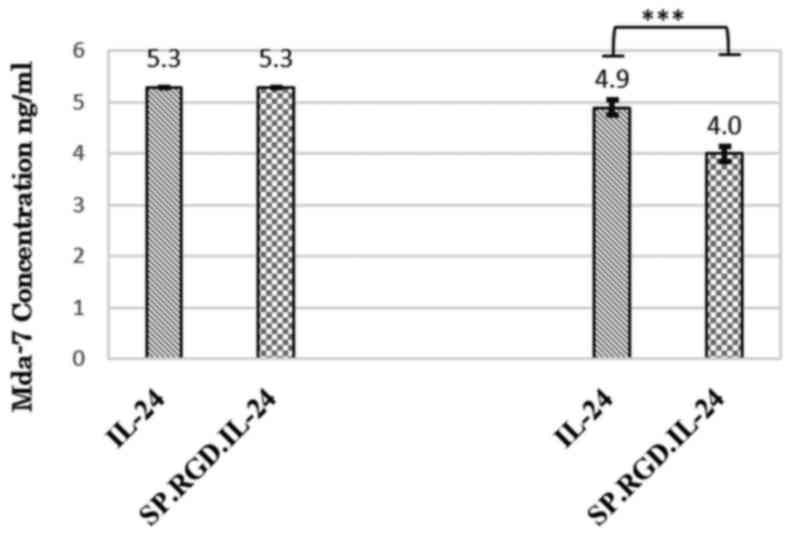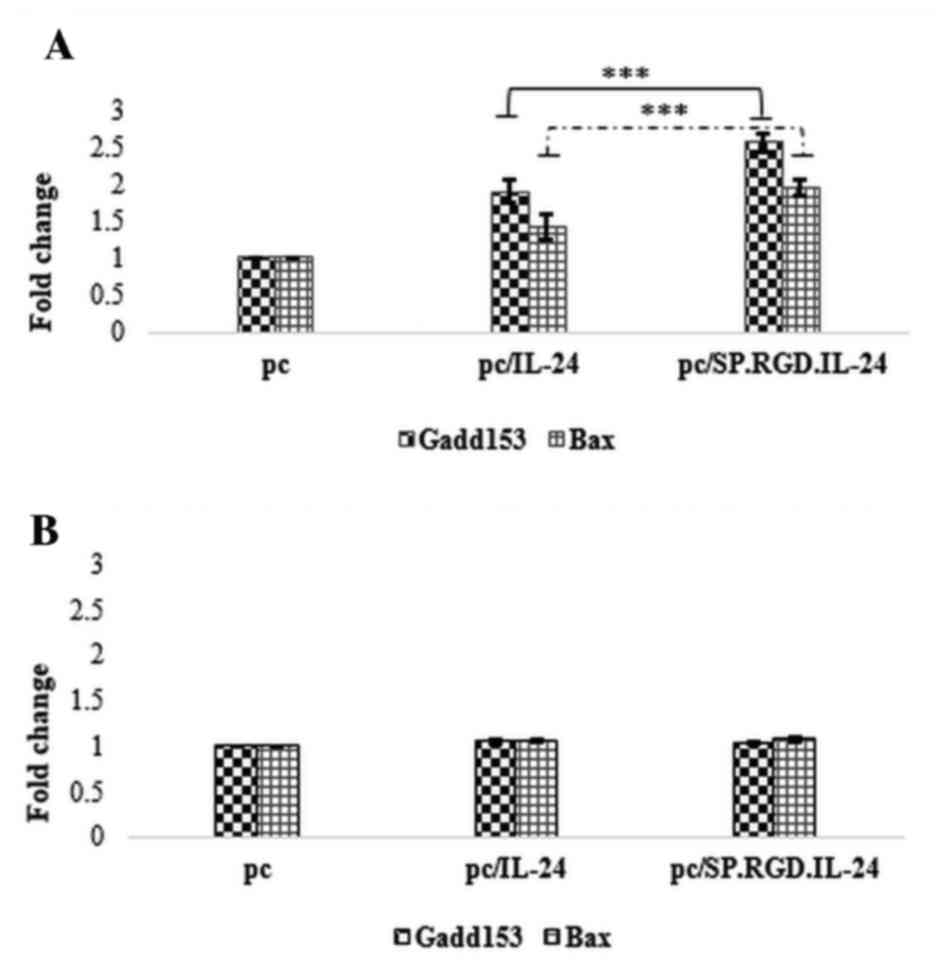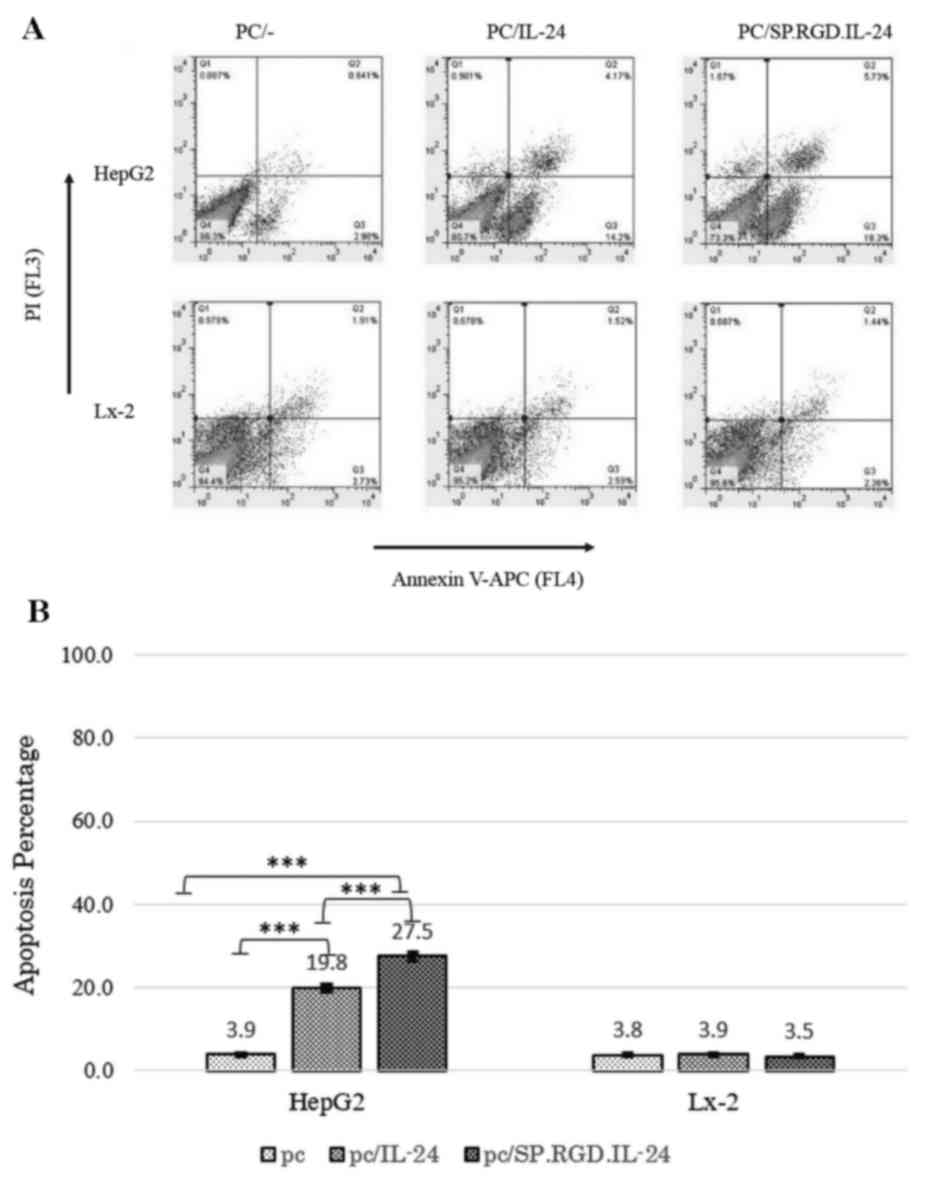|
1
|
Ekmekcioglu S, Ellerhorst J, Mhashilkar
AM, Sahin AA, Read CM, Prieto VG, Chada S and Grimm EA:
Down-regulated melanoma differentiation associated gene (mda-7)
expression in human melanomas. Int J Cancer. 94:54–59. 2001.
View Article : Google Scholar : PubMed/NCBI
|
|
2
|
Ellerhorst JA, Prieto VG, Ekmekcioglu S,
Broemeling L, Yekell S, Chada S and Grimm EA: Loss of MDA-7
expression with progression of melanoma. J Clin Oncol.
20:1069–1074. 2002. View Article : Google Scholar : PubMed/NCBI
|
|
3
|
Zhang J, Sun A, Xu R, Tao X, Dong Y, Lv X
and Wei D: Cell-penetrating and endoplasmic reticulum-locating
TAT-IL-24-KDEL fusion protein induces tumor apoptosis. J Cell
Physiol. 231:84–93. 2016. View Article : Google Scholar : PubMed/NCBI
|
|
4
|
Parrish-Novak J, Xu W, Brender T, Yao L,
Jones C, West J, Brandt C, Jelinek L, Madden K, McKernan PA, et al:
Interleukins 19, 20, and 24 signal through two distinct receptor
complexes. Differences in receptor-ligand interactions mediate
unique biological functions. J Biol Chem. 277:47517–47523. 2002.
View Article : Google Scholar : PubMed/NCBI
|
|
5
|
Persaud L, De Jesus D, Brannigan O,
Richiez-Paredes M, Huaman J, Alvarado G, Riker L, Mendez G, Dejoie
J and Sauane M: Mechanism of Action and Applications of Interleukin
24 in Immunotherapy. Int J Mol Sci. 17(pii): E8692016.PubMed/NCBI
|
|
6
|
Lebedeva IV, Emdad L, Su ZZ, Gupta P,
Sauane M, Sarkar D, Staudt MR, Liu SJ, Taher MM, Xiao R, et al:
mda-7/IL-24, novel anticancer cytokine: Focus on bystander
antitumor, radiosensitization and antiangiogenic properties and
overview of the phase I clinical experience (Review). Int J Oncol.
31:985–1007. 2007.PubMed/NCBI
|
|
7
|
Emdad L, Lebedeva IV, Su ZZ, Gupta P,
Sauane M, Dash R, Grant S, Dent P, Curiel DT, Sarkar D and Fisher
PB: Historical perspective and recent insights into our
understanding of the molecular and biochemical basis of the
antitumor properties of mda-7/IL-24. Cancer Biol Ther. 8:391–400.
2009.PubMed/NCBI
|
|
8
|
Nishikawa T, Ramesh R, Munshi A, Chada S
and Meyn RE: Adenovirus-mediated mda-7 (IL24) gene therapy
suppresses angiogenesis and sensitizes NSCLC xenograft tumors to
radiation. Mol Ther. 9:818–828. 2004. View Article : Google Scholar : PubMed/NCBI
|
|
9
|
Pataer A, Bocangel D, Chada S, Roth JA,
Hunt KK and Swisher SG: Enhancement of adenoviral MDA-7-mediated
cell killing in human lung cancer cells by geldanamycin and its
17-allyl- amino-17-demethoxy analogue. Cancer Gene Ther. 14:12–18.
2007. View Article : Google Scholar : PubMed/NCBI
|
|
10
|
Ruoslahti E: The RGD story: A personal
account. Matrix Biol. 22:459–465. 2003. View Article : Google Scholar : PubMed/NCBI
|
|
11
|
Lu X, Lu D, Scully M and kakkar V: The
role of integrins in cancr and integrin therapeutic agent for
cancer therapy. Perspect Medicin Chem. 2:57–73. 2008.PubMed/NCBI
|
|
12
|
Brooks PC, Clark RA and Cheresh DA:
Requirement of vascular integrin alpha v beta 3 for angiogenesis.
Science. 264:569–571. 1994. View Article : Google Scholar : PubMed/NCBI
|
|
13
|
Assa-Munt N, Jia X, Laakkonen P and
Ruoslahti E: Solution structures and integrin binding activities of
an RGD peptide with two isomers. Biochemistry. 40:2373–2378. 2001.
View Article : Google Scholar : PubMed/NCBI
|
|
14
|
Arap W, Pasqualini R and Ruoslahti E:
Cancer treatment by targeted drug delivery to tumor vasculature in
a mouse model. Science. 279:377–380. 1998. View Article : Google Scholar : PubMed/NCBI
|
|
15
|
Dickerson EB, Akhtar N, Steinberg H, Wang
ZY, Lindstrom MJ, Padilla ML, Auerbach R and Helfand SC:
Enhancement of the antiangiogenic activity of interleukin-12 by
peptide targeted delivery of the cytokine to alphavbeta3 integrin.
Mol Cancer Res. 2:663–673. 2004.PubMed/NCBI
|
|
16
|
Curnis F, Gasparri A, Sacchi A, Longhi R
and Corti A: Coupling tumor necrosis factor-alpha with alphaV
integrin ligands improves its antineoplastic activity. Cancer Res.
64:565–571. 2004. View Article : Google Scholar : PubMed/NCBI
|
|
17
|
Craig R, Cutrera J, Zhu S, Xia X, Lee YH
and Li S: Administering plasmid DNA encoding tumor vessel-anchored
IFN-alpha for localizing gene product within or into tumors. Mol
Ther. 16:901–906. 2008. View Article : Google Scholar : PubMed/NCBI
|
|
18
|
Sauane M, Su ZZ, Gupta P, Lebedeva IV,
Dent P, Sarkar D and Fisher PB: Autocrine regulation of mda-7/IL-24
mediates cancer-specific apoptosis. Proc Natl Acad Sci USA.
105:9763–9768. 2008. View Article : Google Scholar : PubMed/NCBI
|
|
19
|
Khodadad M, Hosseini SY, Shenavar F,
Erfani N, Bina S, Ahmadian S, Fattahi MR and Hajhosseini R:
Construction of expressing vectors including melanoma
differentiation-associated gene-7 (mda-7) fused with the RGD
sequences for better tumor targeting. Iran J Basic Med Sci.
18:780–787. 2015.PubMed/NCBI
|
|
20
|
Barash S, Wang W and Shi Y: Human
secretory signal peptide description by hidden Markov model and
generation of a strong artificial signal peptide for secreted
protein expression. Biochem Biophys Res Commun. 294:835–842. 2002.
View Article : Google Scholar : PubMed/NCBI
|
|
21
|
Petersen TN, Brunak S, von Heijne G and
Nielsen H: SignalP 4.0: Discriminating signal peptides from
transmembrane regions. Nat Methods. 8:785–786. 2011. View Article : Google Scholar : PubMed/NCBI
|
|
22
|
Livak KJ and Schmittgen TD: Analysis of
relative gene expression data using real-time quantitative PCR and
the 2(−Delta Delta C(T)) Method. Methods. 25:402–408. 2001.
View Article : Google Scholar : PubMed/NCBI
|
|
23
|
Dent P, Yacoub A, Hamed HA, Park MA, Dash
R, Bhutia SK, Sarkar D, Gupta P, Emdad L, Lebedeva IV, et al:
MDA-7/IL-24 as a cancer therapeutic: From bench to bedside.
Anticancer Drugs. 21:725–731. 2010. View Article : Google Scholar : PubMed/NCBI
|
|
24
|
Pei DS, Yang ZX, Zhang BF, Yin XX, Li LT,
Li HZ and Zheng JN: Enhanced apoptosis-inducing function of
MDA-7/IL-24 RGD mutant via the increased adhesion to tumor cells. J
Interferon Cytokine Res. 32:66–73. 2012. View Article : Google Scholar : PubMed/NCBI
|
|
25
|
Bina S, Shenavar F, Khodadad M, Haghshenas
MR, Mortazavi M, Fattahi MR, Erfani N and Hosseini SY: Impact of
RGD peptide tethering to IL24/mda-7 (Melanoma Differentiation
Associated Gene-7) on apoptosis induction in hepatocellular
carcinoma cells. Asian Pac J Cancer Prev. 16:6073–6080. 2015.
View Article : Google Scholar : PubMed/NCBI
|
|
26
|
Xiao B, Li W, Yang J, Guo G, Mao XH and
Zou QM: RGD-IL-24, a novel tumor-targeted fusion cytokine:
Expression, purification and functional evaluation. Mol Biotechnol.
41:138–144. 2009. View Article : Google Scholar : PubMed/NCBI
|
|
27
|
Ma Q, Jin B, Zhang Y, Shi Y, Zhang C, Luo
D, Wang P, Duan C, Song H, Li X, et al: Secreted recombinant human
IL-24 protein inhibits the proliferation of esophageal squamous
cell carcinoma Eca-109 cells in vitro and in vivo. Oncol Rep.
35:2681–2690. 2016.PubMed/NCBI
|
|
28
|
Sieger KA, Mhashilkar AM, Stewart A,
Sutton RB, Strube RW, Chen SY, Pataer A, Swisher SG, Grimm EA,
Ramesh R and Chada S: The tumor suppressor activity of MDA-7/IL-24
is mediated by intracellular protein expression in NSCLC cells. Mol
Ther. 9:355–367. 2004. View Article : Google Scholar : PubMed/NCBI
|
|
29
|
Su ZZ, Madireddi MT, Lin JJ, Young CS,
Kitada S, Reed JC, Goldstein NI and Fisher PB: The cancer growth
suppressor gene mda-7 selectively induces apoptosis in human breast
cancer cells and inhibits tumor growth in nude mice. Proc Natl Acad
Sci USA. 95:14400–14405. 1998. View Article : Google Scholar : PubMed/NCBI
|
|
30
|
Sarkar D, Su ZZ, Lebedeva IV, Sauane M,
Gopalkrishnan RV, Valerie K, Dent P and Fisher PB: mda-7 (IL-24)
Mediates selective apoptosis in human melanoma cells by inducing
the coordinated overexpression of the GADD family of genes by means
of p38 MAPK. Proc Natl Acad Sci USA. 99:10054–10059. 2002.
View Article : Google Scholar : PubMed/NCBI
|
|
31
|
Tait SW and Green DR: Mitochondria and
cell death: Outer membrane permeabilization and beyond. Nat Rev Mol
Cell Biol. 11:621–632. 2010. View
Article : Google Scholar : PubMed/NCBI
|
|
32
|
Wang CJ, Xue XB, Yi JL, Chen K, Zheng JW,
Wang J, Zeng JP and Xu RH: Melanoma differentiation-associated
gene-7, MDA-7/IL-24, selectively induces growth suppression,
apoptosis in human hepatocellular carcinoma cell line HepG2 by
replication-incompetent adenovirus vector. World J Gastroenterol.
12:1774–1779. 2006. View Article : Google Scholar : PubMed/NCBI
|
|
33
|
Nishikawa T, Ramesh R, Munshi A, Chada S
and Meyn RE: Adenovirus-mediated mda-7 (IL24) gene therapy
suppresses angiogenesis and sensitizes NSCLC xenograft tumors to
radiation. Mol Ther. 9:818–828. 2004. View Article : Google Scholar : PubMed/NCBI
|
|
34
|
Zhao L, Gu J, Dong A, Zhang Y, Zhong L, He
L, Wang Y, Zhang J, Zhang Z, Huiwang J, et al: Potent antitumor
activity of oncolytic adenovirus expressing mda-7/IL-24 for
colorectal cancer. Hum Gene Ther. 16:845–858. 2005. View Article : Google Scholar : PubMed/NCBI
|
|
35
|
Pan X, Wu L, Cao J, Guo W, Wang Z, Han B
and Hu W: Recombinant adenovirus vector-mediated human MDA-7 gene
transfection suppresses hepatocellular carcinoma growth in a mouse
xenograft model. J Biomed Res. 26:53–58. 2012. View Article : Google Scholar : PubMed/NCBI
|

















